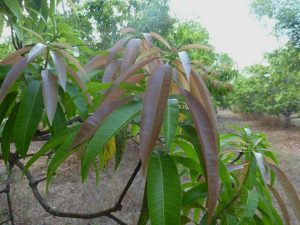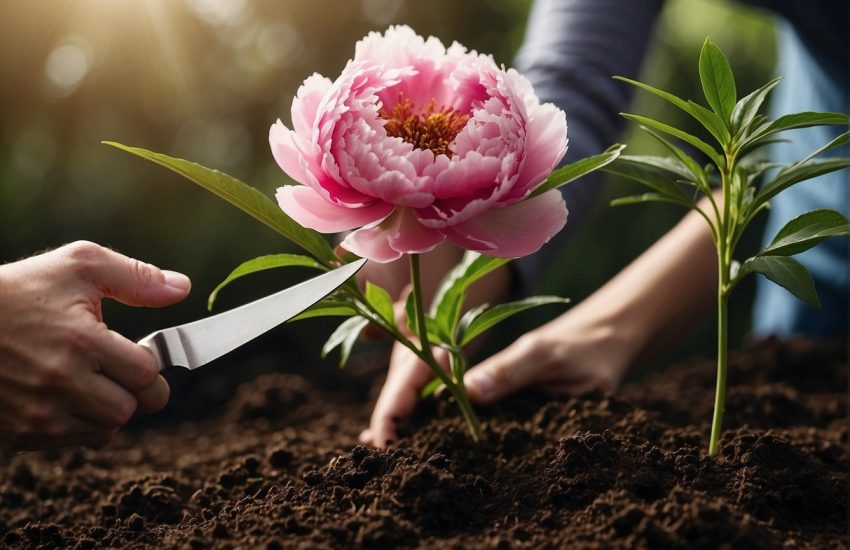Mango Tree Leaves Turning Brown – Reasons and Prevention
The mango is a popular fruit because of its sweet and juicy taste! In addition, it is also an excellent source of vitamins A, B6, and C. This makes it a low-calorie, nutrient-rich food that can help to manage diabetes or reduce your cholesterol levels. Mangoes are eaten raw, but Asians also use them for cooking and desserts such as sorbets or ice creams.
The iconic tree bears large green leaves susceptible to burning and browning at their tips. This type of injury is called tipburn, stemming from the tips of the leaves. It might happen during the early development stage of the mango tree. If it happens after that, then it could be caused by poor drainage.
Additionally, if the roots are too wet or too dry, they may not absorb proper nutrients and water through the soil and may become damaged or even die due to a lack of nutritious water.

Causes of Brown Mango Leaves Turning Brown
Environmental Factors
Soil quality and pH play an important part in the healthy growth of mango trees. The soil must be rich and well-drained for the tree to absorb nutrients properly. Ensure that you raise the pH of the soil if it is too acidic for optimal growth. The pH has a direct relationship with the leaves turning brown.
Magnesium Deficiency
For optimum growth, your soil must be rich enough in magnesium. Magnesium is responsible for bringing out the vibrant color of the leaves on your mango tree leaves. If too little magnesium is available in your soil, it may cause the leaves to turn brown. The deficiency might also result from build-up due to too much fertilizer or improper drainage.
High temperatures
Yes, high temperatures also cause the leaves to turn brown, but they are not as serious a problem as other factors. If the temperature is too high for too long a period, then it might burn the leaves. But the soil where your mango tree is planted should be well-drained, and you’ll still be able to grow healthy mango leaves.
Treatment
To effectively treat brown mango leaves, be sure to discover the causes. We recommend that you learn how to grow a mango tree to prevent more problems. Once you know the problem, take appropriate steps to solve it. Here are a few tips for treating the problem:
Correct pH
While environmental conditions are a large factor, it is important to know that the pH in your soil must also be correct. Ensure the pH is not too acidic or too basic for optimum growth. A balanced PH of 6 to 7 will give your mango tree a healthy and green environment. If the soil’s pH is high or low, it will affect the nutrient absorption of your mango tree leaves even further. Look for a fertilizer with the right elements range for the best growth rates.
Foliar Spray
If the cause is magnesium deficiency, applying a foliar spray will help correct the problem. Spray the leaves with magnesium sulfate solution, and the sprouts become green and healthy. For salt build-up, you can consider heavy watering and regular removal of the vase to remove the salt.
Watering
Watch the watering levels of your mango tree carefully; you might want to increase the watering of your plant if it has been exposed to too much sun. A good rule is to keep the soil moist. If your leaves show brown spots and you still want water more often, try sprinkling a dash of baking soda on the leaves.
This will help prevent the leaves from burning and greying at their tips. Remember to avoid over-watering during winter as this can cause root rot or greater fungal problems in future summers. When you water your trees, do so in well-drained areas that don’t have standing water.
Too much water creates a moist environment that tends to be warm, prone to fungus growth, and encourages pests and diseases. If you need to water your trees, don’t overwater them.
Mango Tree Diseases
Besides the main mango tree leaves turning brown, several other diseases can occur. Some of the common mango tree diseases include:
Powdery Mildew
This fungus disease afflicts flowers, young fruit, and leaves. The fungal spores spread by wind and cause lesions on the leaves. These leaves turn yellow and fall off. The flowers are also affected by this disease and become deformed.
Anthracnose
Anthracnose causes leaf spots with purple to black or dark brown centers. It is characterized by flower blight, fruit rot, twig blight, shoot blight, trunk rot, and leaf blister spots. When the infection is severe, then it can lead to defoliation and even tree death in extreme cases.
Verticillium Wilt
This soil-borne fungus affects the roots, trunk, branches, and leaves. The disease results in wilting of the plant and makes it susceptible to pests and water stress. More commonly seen in young trees, older trees are hardier due to their hardened roots. However, they may develop symptoms when under stress owing to other factors like over-watering.
Mango Scab
This fungal disease is characterized by leaf spots turning gray or brown scabs. There are also instances when the cork layer of the trunk is infected and develops large scars. The spores spread by splashing rainwater and via insects.
How to Prevent and Control Mango Diseases
Fungicide Sprays
Keep an eye on your mango tree leaves, and you should see a build-up of fungus spores that might result in a mango scab. Use a fungicide spray to prevent it from spreading to other areas of the plant. You can spray the trunks and branches as well as the undersides of the leaves to control this disease.
Make sure you re-apply fungicide sprays well before the leaves turn brown and fall off the branches, as this is usually an indication for them to do so. Mango tree diseases are most common in the springtime when the leaves lack chlorophyll pigment making them more susceptible to infection. This is where fungicides come in handy, as they will help prevent further losses of these vital parts of your plants.
Weed Regularly
When weeds grow around the base of the plant, it poses a threat as they might restrict proper root growth and sunlight penetration, among other things. Many diseases may be spread from these weeds. Ensure that you regularly weed around the base of the plant and between the tree trunk.
Thick mulching around the base of your mango tree will help prevent weeds from being a threat to it. Since weeds compete for moisture, creating a thick mulch around their root zone can prevent this. This is especially helpful in areas where pests are common. Making sure you mulch well also protects your soil from erosion and helps retain moisture levels in its surrounding area.
Practice Good Fertilization
Mango trees should always have a balanced diet of nitrogen, phosphorus, and potassium. These elements help improve the overall growth of your tree and may prevent some stunted growth. Too much nitrogen may result in the lower leaves turning yellow or falling off, while too much phosphorous and potassium will cause the foliage to become pale. The symptoms would also include the shedding of fruit and flowers and a decline in the overall production rate. It is important to maintain proper fertilization so that these problems do not occur.
Grow Disease Resistant Cultivars
You can prevent many mango tree diseases by choosing disease-resistant cultivars. The nurseries usually label these and will have details about their resistance to problems like anthracnose and powdery mildew.
Mango Tree Pruning
Pruning helps improve circulation and light penetration to the leaves, enhancing photosynthesis and reducing stress on the trees. However, pruning should be performed when the fruit is not on the tree. This is because fruit requires sufficient levels of carbohydrates, which are mostly produced during this season. Furthermore, pruned trees tend to bear more fruits that are larger compared to non-pruned trees.
Use sharp trimmers or hand shears to cut healthy buds without damaging them. When cutting new growth, ensure they are not too close to the main stem so they do not dry up easily during dry weather.
How to Prune Your Mango Tree
Mango pruning is essential for maintaining healthy growth and optimum fruiting potential. While some people may see it as cutting down the entire tree, it is not like that. Instead, it is just trimming off excess shoots and branches since they can sometimes block your view, grow too tall or obstruct the light source. Although there are many cuts that you can make in your mango tree, some types of pruning require other steps. Look through this list to see which stage you will need to take:
Fall Pruning
This pruning should be performed in the fall. Start by removing dead and damaged leaves from the lower half of your plant. Then, use sharp shears to remove shoots and branches from the upper half of your mango tree, as they do not require much maintenance during this time of year. The top part of your tree needs more protection during this time since it is more prone to damage by wind or other factors.
Spring Pruning
Spring pruning should be done shortly after the end of your spring season. This is usually between March and April or whenever the tree starts to flower. The goal is to remove shoots on the upper part of your tree and at its base.
Harvesting Mangoes
As mentioned earlier, your mango trees bear fruit yearly, usually in the summertime. Mango harvesting is exciting, especially if it is your first fruit harvest. You should pick ripe mangoes for harvest as they will have a sweet taste that might linger on your tongue for a long time after you eat them.
Your mango tree can yield hundreds of fruits, so you must know how to pick ripe mangoes ready for harvest. Generally, they should have a bright, shiny skin color which is yellow-orange and smooth textured skin when lightly squeezed by hand. It can also be yellow to red. The fruit should be firm and heavy for its size.
When harvesting your mangoes, you may need a mango nail or cutting pole, which has a sharp point for penetrating the fruit and a long handle to help you reach them from their higher positions in the tree. Use this to tap the ripe mangoes from the tree gently.
Be sure to use a strong rope or slingshot with a soft cushion to harvest fruit. The cushion will prevent any scratches on your tree trunk. You can tie one end of the string to your harvesting tool and get another person to retrieve it from below.
Conclusion
Mango tree care is well worth the effort since it provides delicious fruit you can enjoy with your family. The process starts with finding a good cultivar and properly planting it, so the tree grows and produces fruit for decades.
As your mango trees mature, you will start to harvest fruits in various sizes and colors. The size, shape, and taste can differ depending on your chosen cultivar. However, they all have a sweet, pleasant taste and are best eaten when they are ripe or near ripe.


